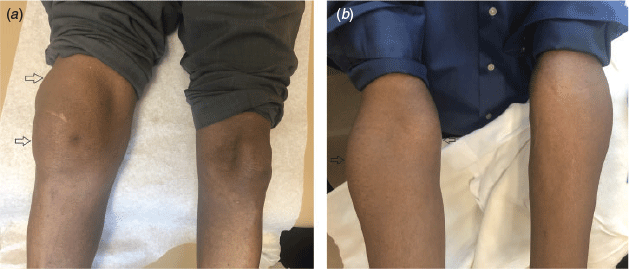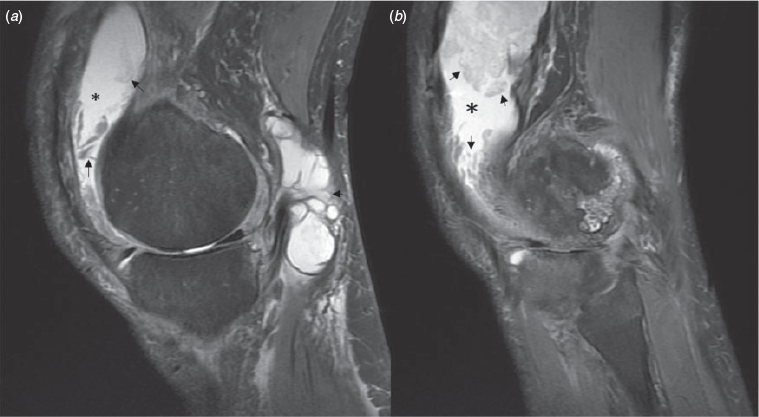Unilateral knee effusion in an elderly patient: an unusual presentation of rheumatoid arthritis
Morteza Khodaee 1 3 , Lindsay Ogle 2 , Cleveland Piggott 11 University of Colorado School of Medicine, Department of Family Medicine & Orthopedics, Division of Sports Medicine, AF Williams Clinic, Denver, Colorado, USA
2 University of Colorado School of Medicine, Swedish Family Medicine Residency, Aurora, Colorado, USA
3 Corresponding author. Email: Morteza.khodaee@cuanschutz.edu
Journal of Primary Health Care 12(4) 391-394 https://doi.org/10.1071/HC20035
Published: 16 September 2020
Journal Compilation © Royal New Zealand College of General Practitioners 2020 This is an open access article licensed under a Creative Commons Attribution-NonCommercial-NoDerivatives 4.0 International License
Abstract
Unilateral atraumatic knee effusion is a relatively common presenting complaint among geriatric patients in primary care and musculoskeletal speciality clinics. Gout, pseudogout, degenerative joint diseases and reactive arthritis are the most common causes of the atraumatic knee effusions. Rheumatoid arthritis very rarely presents as arthritis of one or two large joints. Arthrocentesis, plain radiography and screening blood tests should be performed to help narrow the differential diagnosis. In some cases, advanced imaging modalities such as MRI may be indicated. This study reports a case of rheumatoid arthritis in a 75-year-old gentleman with oligoarthropathy of two large joints as the presenting symptoms.
KEYwords: Synovitis; rheumatoid arthritis; arthrocentesis; oligoarthropathy
Introduction
Rheumatoid arthritis (RA) is the most common systemic inflammatory arthritis, with worldwide prevalence of ~0.5–1%.1,2 It is more common among women, with the peak incidence between age 55 and 65 years.1,2 The hallmark of RA is symmetric involvement of small joints. Large joints involvement, particularly as a presenting condition, is rare. The purpose of this report is to remind clinicians to not regard typical presentations of common conditions as the only possibility in the differential diagnosis. Clinicians should follow basic and logical approaches to any case, starting with a thorough history and physical examination and obtaining appropriate imaging and laboratory tests.
Case report
A gentleman aged 75 years presented with bilateral (right worse than left) knee pain for years. Previously, he was told that he had knee osteoarthritis. Due to personal preference, he has refused any intra-articular corticosteroids or viscosupplement injections in the past. He complains of right knee swelling with inability to bend his knee beyond 90°. On further questioning, he also mentions right elbow pain and swelling. His past medical history is significant for well-controlled type 2 diabetes mellitus, hypertension and hyperlipidemia, for which he is taking metformin, lisinopril, and atorvastatin. During physical examination, he is afebrile with normal vital signs. He has significant right knee effusion with mild joint line tenderness and palpable synovitis (Figure 1a). His right elbow examination also revealed significant effusion and synovitis (Figure 1b). Plain radiography showed mild-to-moderate degenerative changes (Figure 2).

|

|
Arthrocentesis of the right knee joint with an 18-gauge needle (inner diameter of 0.838 mm) produced 47 mL of cloudy synovial fluid with obvious synovial tissue (Figure 3). Laboratory investigations revealed unremarkable complete blood cell counts, comprehensive metabolic panel, hemoglobin A1c of 6.1% (reference range [RR] 4.0–6.0%) and uric acid of 6.1 (RR 4.4–7.6 mg/dL). He had a negative antinuclear antibodies (ANA) and elevated C-reactive protein (CRP) of 25.7 (RR <10.0 mg/L) and an erythrocyte sedimentation rate (ESR) of 47 (RR <10 mm/h). Rheumatoid factor (RF) was 268 (RR 0–14I U/mL) and anti-cyclic citrullinated peptide (anti-CCP) was >200 U (levels >60 U consistent with strong positive). His urine chlamydia, gonorrhoea and trichomonas nucleic acid amplification tests were negative. There were no crystals in his synovial fluid, with a synovial fluid nucleated cell count of 25,175 per mm3 (76% segmented neutrophils) and a red blood cell count of 13,000 per mm3.

|
A MRI revealed severe tricompartmental osteoarthritis with broad areas of full-thickness cartilage loss, subchondral cystic change and oedema. There was a large effusion with exuberant synovitis throughout the joint (Figure 4).

|
The patient was counselled about his new diagnosis of RA and therapeutic options during the following visit. However, he decided not to start any treatment at this point, and wanted to follow up with his primary care provider in the coming months.
Discussion
Rheumatoid arthritis typically presents as polyarthritis of multiple small joints and associated constitutional symptoms.1,2 Extra-articular manifestations are common. Diagnosis is currently based on the 2010 American College of Rheumatology–European League Against Rheumatism Classification.3 Criteria include joint involvement (most points given to polyarthritis of small joints), chronicity (at least 6 weeks), elevated acute-phase reactants (CRP, ESR) and positive serology (RF, anti-CCP).3 A total of at least six points out of maximum 10 defines the diagnosis of RA.3 In this system, zero points are given to patients who present with mono-arthritis of a large joint (ie shoulder, elbow, hip, knee and ankle).3
Although RA incidence is four- to five-fold higher in females than in males aged <50 years, the female-to-male ratio is only two-fold higher in patients aged >60–70 years.4 Additionally, RA should remain on the differential diagnosis of mono-arthropathy or oligo-arthropathy despite rarely presenting initially as swelling of a single large joint.1–3,5–7 This is especially true for patients who do not have a clear diagnosis and their symptoms do not improve after standard treatment for common conditions such as osteoarthritis or gout.1,2,6,7 A potential approach to avoid delays in diagnosis and treatment of RA would be to implement early plain radiographic imaging in all patient who present with monoarthritis.1–3,6 This practice would close the gap between the 2010 ACR/EULAR criteria and the previous 1987 ACR criteria, which included radiographic changes.1–3
In cases with unexplained monoarticular or polyarticular arthritis lasting for >6 weeks, RA should be in the differential diagnosis.1–3,7 Other more common aetiologies, such as gout, pseudogout and reactive arthritis (eg chlamydia, gonorrhoea and viral hepatitis) should be ruled out. Obtaining early plain radiographic imaging and arthrocentesis with a large-bore needle is an important diagnostic tool to help with the diagnosis.6,7
Competing Interests
The authors declare no competing interests.
Funding
This research did not receive any specific funding.
Acknowledgement
This work was performed at the University of Colorado School of Medicine, Colorado, USA.
References
[1] Aletaha D, Smolen JS. Diagnosis and management of rheumatoid arthritis: a review. JAMA. 2018; 320 1360–72.| Diagnosis and management of rheumatoid arthritis: a review.Crossref | GoogleScholarGoogle Scholar | 30285183PubMed |
[2] Allen A, Carville S, McKenna F, Guideline Development Group Diagnosis and management of rheumatoid arthritis in adults: summary of updated NICE guidance. BMJ. 2018; 362 k3015
| Diagnosis and management of rheumatoid arthritis in adults: summary of updated NICE guidance.Crossref | GoogleScholarGoogle Scholar | 30076129PubMed |
[3] Aletaha D, Neogi T, Silman AJ, et al. 2010 Rheumatoid arthritis classification criteria: an American College of Rheumatology/European League Against Rheumatism collaborative initiative. Arthritis Rheum. 2010; 62 2569–81.
| 2010 Rheumatoid arthritis classification criteria: an American College of Rheumatology/European League Against Rheumatism collaborative initiative.Crossref | GoogleScholarGoogle Scholar | 20872595PubMed |
[4] Kvien TK, Uhlig T, Odegard S, Heiberg MS. Epidemiological aspects of rheumatoid arthritis: the sex ratio. Ann N Y Acad Sci. 2006; 1069 212–22.
| Epidemiological aspects of rheumatoid arthritis: the sex ratio.Crossref | GoogleScholarGoogle Scholar | 16855148PubMed |
[5] Devaraj NK. The atypical presentation of rheumatoid arthritis in an elderly woman: a case report. Ethiop J Health Sci. 2019; 29 957–8.
| 30700964PubMed |
[6] Sarazin J, Schiopu E, Namas R. Case series: monoarticular rheumatoid arthritis. Eur J Rheumatol. 2017; 4 264–7.
| Case series: monoarticular rheumatoid arthritis.Crossref | GoogleScholarGoogle Scholar | 29308281PubMed |
[7] Weissman S, Alsheikh M, Kamar K, et al. Non-insidious large joint manifestation of severe cachectic rheumatoid arthritis. Cureus. 2018; 10 e3266
| Non-insidious large joint manifestation of severe cachectic rheumatoid arthritis.Crossref | GoogleScholarGoogle Scholar | 30656082PubMed |


